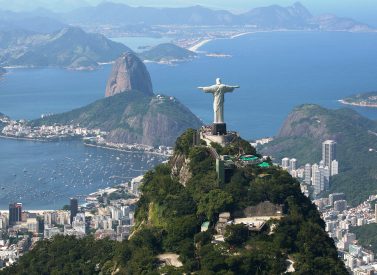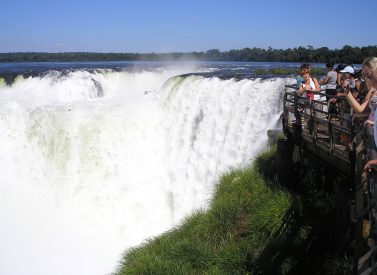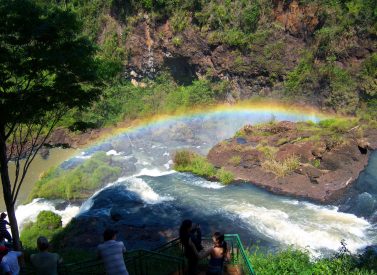Guide to the Best Time to Visit Iguazu Falls
 by Tom Shearman on 14th March, 2022
by Tom Shearman on 14th March, 2022
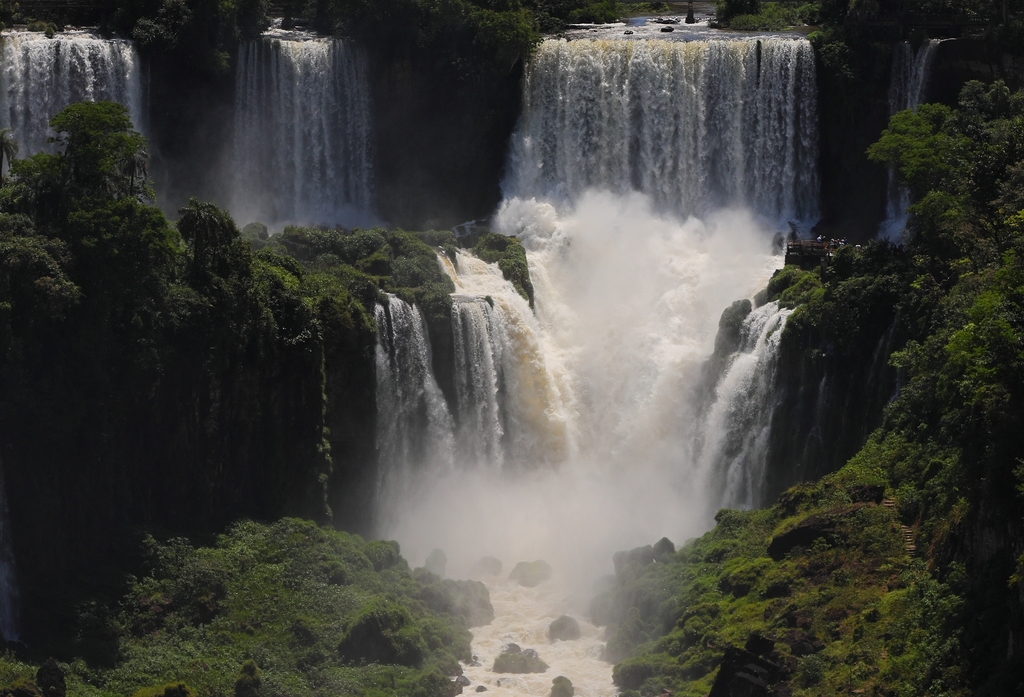
Visiting Iguazu Falls is a once-in-a-lifetime travel experience with thundering waterfalls and lush rainforests. Let’s look at the best time to visit Iguazu Falls so that you can make the most of this popular and outstanding destination.
Of course, the best time to visit Iguazu Falls is subjective.
Hate the heat but want to see high water levels? Perhaps you are an April person. Want to avoid the crowds but want the best chance of clear blue skies? August may fit the bill.
This guide to the best time to visit Iguazu Falls will give you all the travel tips, from temperatures to mosquito season and on how to avoid the crowds, whenever you visit.
Introduction to Iguazu Falls
Iguazu Falls — or Foz do Iguaçu in Brazil — was voted one of seven natural wonders of the world and is a UNESCO World Heritage Site. The name means ‘big water’ and originates from the Paraguayan Guarani language, in which they are called Chororõ Yguasu.
Iguazu comprises 275 individual cascades that line a 4km/2.5 miles long crescent-shaped cliff, some falling up to 82m/269ft into the gorge below. Up to 450,000 cubic feet of water can pass over the falls every second when they are at their mightiest.
Three countries meet at the falls. Brazil and Argentina’s borders meet at the Falls and the Iguassu river that flows between them. Paraguay’s border is defined by the river Paraná, which runs perpendicular to the outflowing Iguassu river.
Iguazu Falls are second only to Victoria Falls in size – but many say Iguazu is more beautiful. You’ll hear the roar of Iguazu Falls before you see them.
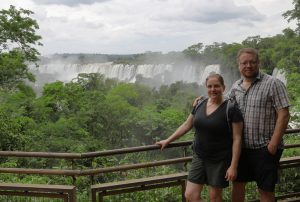
When’s the Best Time to Visit Iguazu Falls?
The best time to visit Iguazu Falls doesn’t necessarily mean when the weather’s best or when the water is highest. The waterfalls enjoy a humid subtropical climate, making it a year-round destination.
In short, it’s hottest and busiest at Iguazu when the Falls’ waters are highest and it’s quieter and cooler in the dry season. The Falls are housed within tropical rainforest with two distinct seasons: hot and wet summers (Oct-Mar) and relatively dry and fresh winters (May-Sep).
You don’t need to suffer steaming hot temperatures to see Iguazu Falls at their broiling best.
- Summer is hot and humid.
- Autumn is the wettest time of year.
- Winter features drier weather and short daylight hours.
- Spring has manageable crowds, blooming foliage, and rushing water.
Rain and temperature are often the most critical aspects of journey planning for visitors.
- Temperature: Summer (Dec-Mar) temperatures can reach 30-35 degrees Celsius (86-95 degrees Fahrenheit), making walking trails sweaty work.
- Rainfall: You’ll probably get wet visiting the waterfalls, so does a bit of extra rain matter? Winter (Jun-Sep) is drier.
- Crowds: Either get to the Falls first thing in the morning during peak season or consider visiting during the shoulder or low season.
- Mosquito season: The tropical climate means the biters will always be around. Winter (Jun-Sep) means fewer mosquitos.
- Budget: Lower season means lower prices for hotels, flights, and possibly tours.
- Water flow: Water flow is highest in Summer (Dec-Feb), but Spring (Sep-Nov) and Autumn (Mar-May) are great times to visit, too. November to March almost always offer spectacular water flow.
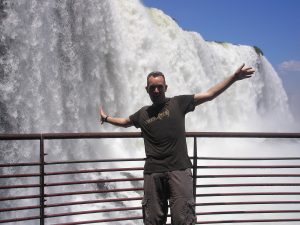
When Are the Peak and Low Seasons at Iguazu Falls?
The busiest times at Iguazu Falls are from Christmas to February, the Easter week, and the second half of July.
Many Argentinians, Brazilians, and South Americans have their holidays at these times. Together with international tourists, it makes finding flights, hotels, and space at the Falls tricky.
Visit during the week if you have to travel during peak season. December has fewer visitors than January and February.
The shoulder seasons of April to May (excluding Easter) and September to October offer warmth but not stifling heat, low possibilities of rainfall, good water levels, and not many tourists.
Peak season pros: Blue skies, impressive water flow.
Peak season cons: Heat and humidity, mosquitos, hotels and flights busy.
Low season pros: High water levels, lower prices, fewer people.
Low season cons: Occasional grey skies and showers, shorter days, cooler nights (which could be a plus for some).
What’s the Weather Like at Iguazu Falls?
Here’s a weather chart showing average temperatures at Iguazu Falls.
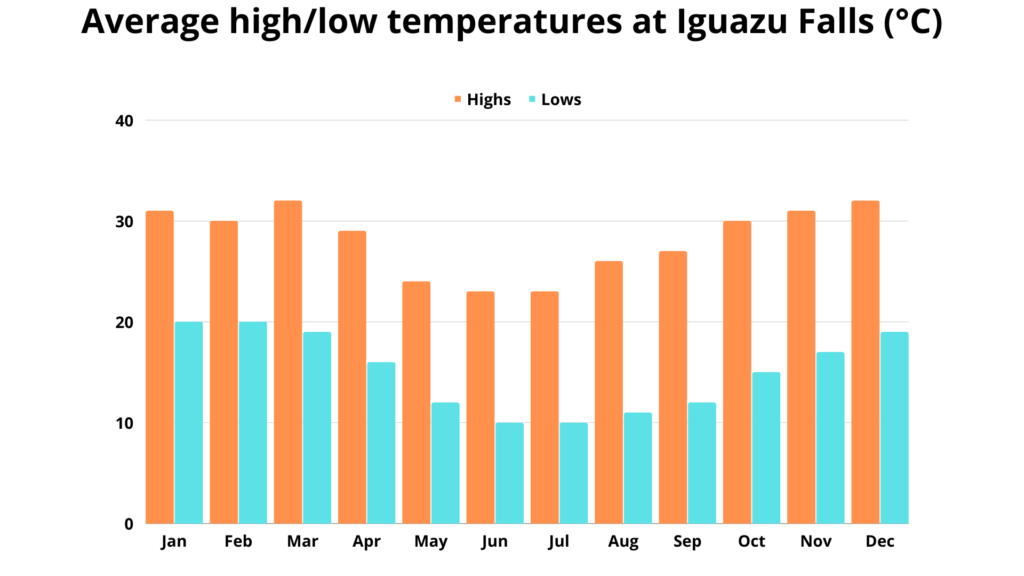
Here’s a weather chart showing average rainfall at Iguazu Falls. Most months have between 8-12 days of rainfall.
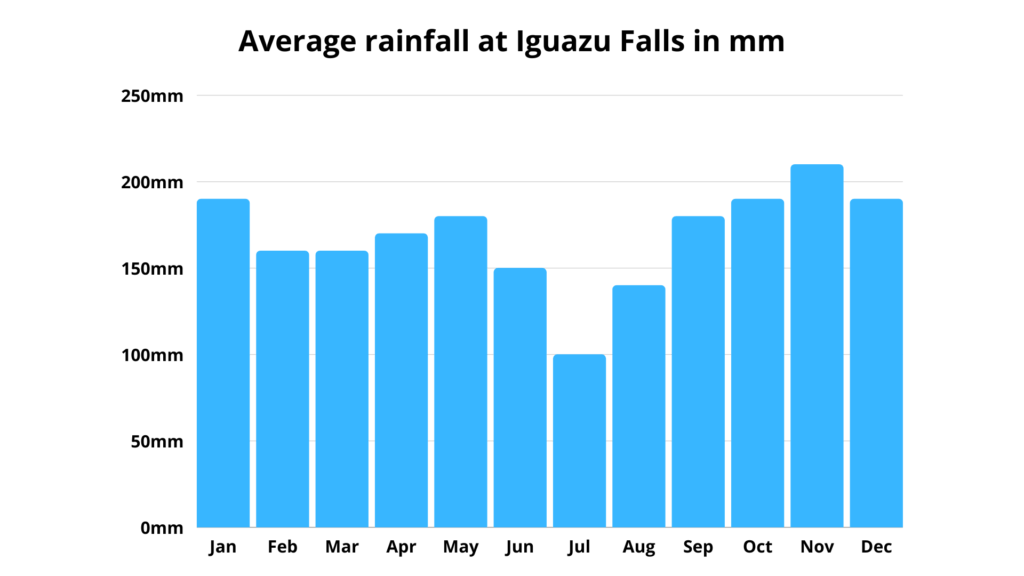
What Are the Different Seasons Like at Iguazu Falls?
The seasons all offer something different. According to your tastes, you can choose the best time to visit Iguazu Falls.
Winter (Jun-Aug)
- Sunny, dry weather.
- Early starts to make the most of shorter days.
- Fewer people apart from the last two weeks of July.
- Possible hotel and flight deals may be available.
Spring (Sep-Nov)
- Warm, humid weather with some rainfall.
- Bring rain gear — November is the wettest month of the year.
- Weather improves and temperatures rise.
- It can be a great time to relax in your hotel’s pool.
Summer (Dec-Feb)
Summer is the peak travel season at Iguazu, especially January and February.
- It’s the hottest time of year.
- High humidity and temperatures of 30-35 degrees Celsius (86-95 degrees Fahrenheit) during the day.
- Stick to shaded paths and enjoy the hotel pool at night.
- Summer requires planning if you wish to travel these months.
Autumn (Mar-May)
It’s still warm and humid at Iguazu, but this is the start of the dry season.
- Water levels start to drop with the lack of rainfall.
- Walkways are dry and easier to navigate, important for families or those unsure of their footing.
- Avoid Easter week, and Spring is a fantastic time to visit.
What Are the Best Months to Visit Iguazu Falls?
There are pros and cons to visiting Iguazu Falls at any time of the year. Here is a quick guide so you can decide which would be the best month to visit Iguazu Falls for you.
Winter
June: Clear skies, comfortable weather for hiking, fewer visitors. Jacket for rainy days.
July: Like June but with shorter days. Beware the last two weeks of July when local tourists and families descend for their winter holidays.
August: A great time to visit, sunny and dry, few crowds, short days, with some hotel discounts.
Spring
September: Days get longer, more rain later in the month, and occasional storms. Few visitors.
October: One of Iguazu’s rainiest month with up to ten rainy days on average: humidity rises.
November: Warmer and sweatier, but you can hike comfortably. Bring a swimsuit and sunscreen, plus a jacket for the night. More visitors (international) arriving. High water volume and rain.
Summer
December: Plan ahead for this hot, humid, and busy time. Early starts to avoid crowds and heat. Water levels are high.
January: Waterfall spray keeps you cool as the temperature remains high. Take cooling rainforest walks, sun cream, lots of water, and some patience.
February: Usually Iguazu’s hottest month, so take advantage of boat rides and waterfall spray. Possible summer storms pass quickly, and the Falls looks dramatic.
Autumn
March: Summer crowds thin out, the water is high, it’s warm, and there are fewer showers.
April: Did we say to avoid Easter week? It’s packed then, otherwise expect blue skies, lower water levels, and fewer people.
May: Iguazu has a tropical climate, so while cooler and clear skies mean fewer visitors, everything remains green. Early starts mean you’ll have the park almost to yourself.
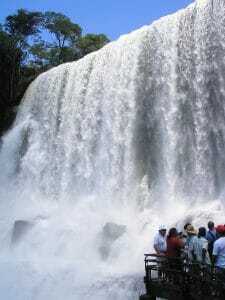
What’s the Best Day of the Week to Visit Iguazu Falls?
Like most famous attractions, Iguazu Falls attracts a lot of local sightseers at weekends.
Whenever you visit, Monday to Friday will have fewer visitors than at weekends. This makes weekdays an excellent option for visiting the Falls with fewer people around.
What’s the Best Time of the Day to Visit Iguazu Falls?
Iguazu Falls are usually open from 8 am to 6 pm, and most organised tours visit the Falls between 10 am and 4 pm.
If your objective is to avoid crowds, the best time of the day to visit Iguazu Falls is early morning when the park opens or later afternoon.
Best Ways To Avoid the Crowds at Iguazu Falls?
The best ways to avoid crowds at Iguazu are:
- Travel low season (May-November but not last two weeks of July).
- Wake early and be the first to the gates (year-round).
- Stay at one of the two hotels within the national park and have the Falls to yourself once the park closes.
- Travel midweek and avoid busier weekends.
When Is the Mosquito Season at Iguazu Falls?
The mosquito season at Iguazu Falls is every month of the year, thanks to its tropical climate. There are more mosquitos from January to April.
The official advice is that Iguazu Falls carries a low malaria risk, and most countries do not advise taking anti-malarial pills for your visit. Always check with your doctor before travelling.
The best advice is to avoid getting bitten. A yellow fever certificate isn’t necessary, either.
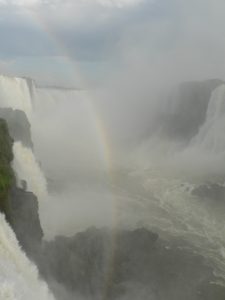
Are There Nocturnal Tours at Iguazu Falls?
Yes, there are nocturnal tours at Iguazu Falls. The Full Moon walking tours take place for five days of every lunar cycle.
Evening entertainment in the towns surrounding the Falls includes tango nights, fine dining experiences, and even learning how to make empanadas.
Any Packing Tips for Iguazu Falls?
Packing tips for Iguazu Falls depend on which season you are travelling. You’ll probably need a warm jacket for nights unless you travel in summer. You will always need sun cream to cope with the tropical climate.
Here are some essentials on top of your standard packing list:
- Good, comfortable walking shoes for trails.
- Sun cream, factor 50 recommended.
- A hat to protect your head from the sun.
- Insect repellent for the mosquitos.
- Bathing suit.
- Light clothing that you don’t mind getting wet.
- Raincoat or waterproof jacket.
- Long-sleeved T-shirts and trousers to help protect against insect bites.
- Towel.
- Dry clothes for changing.
- Sunglasses with UV protection.
- Memory cards/space for photos.
- Camera/phone for pictures.
Should I Visit the Argentina or Brazil Side of Iguazu Falls?
Most of Iguazu Falls (around 80%) are on the Argentine side, but a visit to both is highly recommended.
The Argentine side has three fantastic walks, with the 500m upper walk taking around 45 minutes. The lower path is approximately 1,300m and takes you on a water-soaked ramble that lasts about 90 minutes.
Most people’s highlight is the Devil’s Throat, which requires a short train ride to a walkway that leads to a balcony overlooking this spectacular waterfall. The Devil’s Throat is a U-shaped waterfall, some 82m/269ft high, 150m/492ft wide and 700m/2,297ft long.
The Brazilian National Park offers a photographic panoramic view of the Falls with 3 kilometres and 270+ cascades to admire over an easy, 1km, hour-long walk.
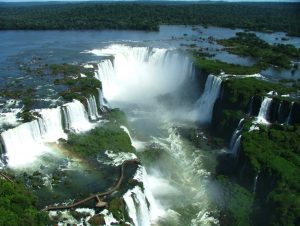
Any Other Travel Tips for Iguazu Falls?
Visit the Argentina side for an up-close and interactive experience – go to the Brazilian side to get the panoramic photo.
People with the budget can stay at one of two top-end hotels located within the park. You can wander around the national park after all the guests have left.
Argentina: Gran Meliá Iguazú
Brazil: Belmond Hotel das Cataratas
The boat tours that go under the Falls offer an exhilarating experience. Some of the Argentina-side hotels have lovely swimming pools, with grounds surrounded by rainforest and make for a relaxing break.
What Animals and Wildlife Can I See at Iguazu Falls?
The Iguazu National Park is actually two national parks. Puerto Iguazu in Argentina became a National Park in 1934, while Foz de Iguazu in Brazil was declared a National Park in 1939. UNESCO World Heritage status was awarded in 1984.
The rainforest surrounding Iguazu Falls is home to some 2,000 plant species, 80 species of trees, and 400 different types of birds. Famous residents include the Harpy Eagle, jaguars, tapirs, howler monkeys, and caiman.
Iguazu is also home to the opossum, the only marsupial found outside Australia.
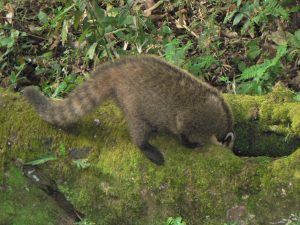
What Is the Local Legend About How Iguazu Falls Formed?
The legend about Iguazu Falls came from God wishing to marry a local girl, Naipí. The lady was not for wooing and escaped on a canoe with her human lover, Tarobá. Furious, God split the River Iguazu in two and created the deep fall, so the young lovebirds would be doomed to fall for all eternity.
How Do I Travel to Iguazu Falls?
Travellers land at one of two airports.
Cataratas de Iguazú International Airport in Argentina has flights to Buenos Aires, Mendoza, and more Argentine cities. Passengers land and transfer about 12 miles to hotels in Puerto Iguazú. It’s a short 6-mile drive from the town to the National Park.
Foz do Iguaçu International Airport is 7 miles east of Foz do Iguaçu and serves destinations in both Argentina and Brazil. Some international flights land here, too, so people can start their tour at Foz do Iguaçu.
Anyone wishing to visit both sides must transit via the official crossing between Puerto Iguazú and Foz do Iguaçu. You can’t walk between the two countries at the National Park.
Where Can I Stay at Iguazu Falls?
Puerto Iguazú in Argentina and Foz do Iguaçu in Brazil have many accommodation options. The Argentine side has more hotels that dip their toes into the rainforest.
Both sides of the national park have a top-end hotel within. In Argentina it’s Gran Meliá Iguazú, and in Brazil, it’s Belmond Hotel das Cataratas.
Now You Know the Best Time to Visit Iguazu Falls
There are many factors to consider when choosing the best time to visit Iguazu Falls. Temperature, humidity, rainfall, and water levels are among the most important for most people.
But, whenever you decide to visit, you cannot help be overawed by this most impressive natural wonder. Contact us for more information.
Contact us for more about Iguazu Falls holidays.
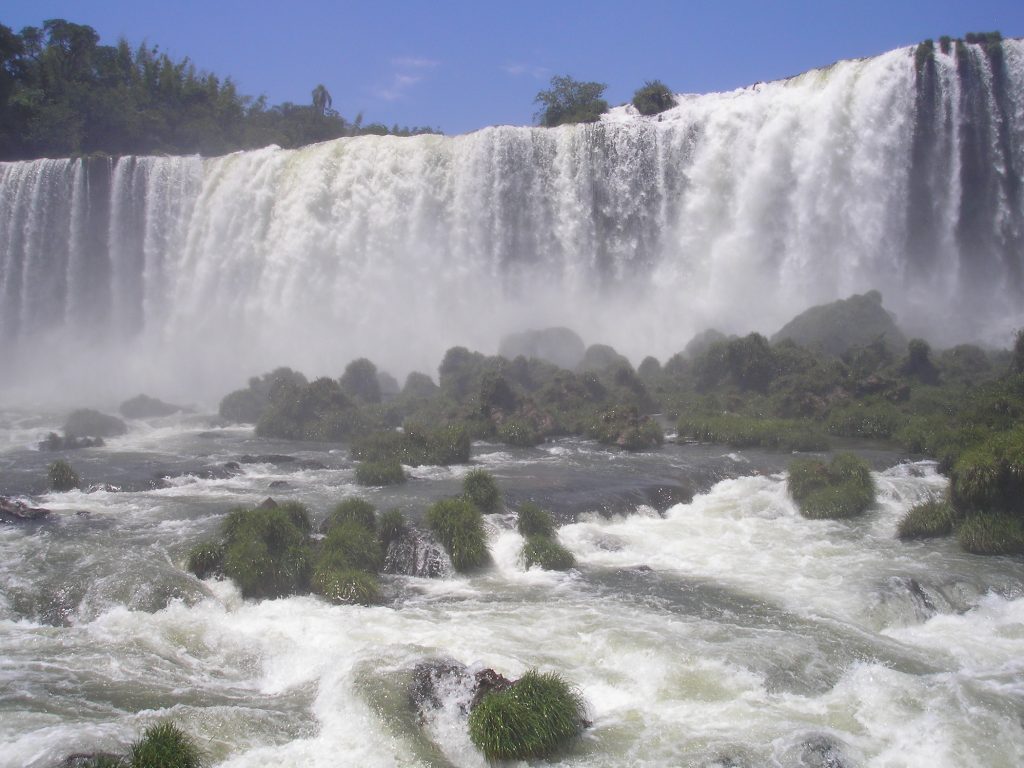


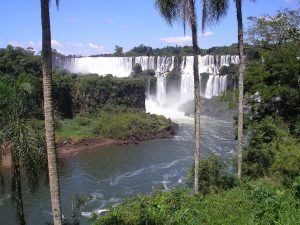
 a Tailor Made Tour
a Tailor Made Tour 